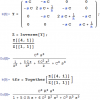My purpose was to point out that Barkhausen's criterion applies to the loop gain, Aß, not Aß-1.
Hi Electrician - back from a one-week vacation (with some time to recall our loop gain problem) I like to reply to your contribution as follows:
I think your explanation cannot show why Ratchs derivation could not give the correct results.
At first - the Barkhausen criterion reqires
Aß=1, which means (phase condition):
Im(Aß)=0.
Rewriting the equation as
Aß-1=0 results in the requirement
Im(Aß-1)=0 which obviously also will give the correct result regarding the phase.
Hence, both formulations of the criterion can be used.
However, if we perform some mathematical manipulations involving the numerator N(jw) and the denominator D(jw) of the expression
ß(jw)=N(jw)/D(jw)=1 we must take into account TWO equations for the real as well as the imag. part (for simplicity I have assumed assumed
A=1):
Let´s rewrite the last equation as follows:
N(jw)=D(jw).
In words: The oscillation condition would be fulfilled if the real parts and the imaginary parts of the numerator N(jw) and the denominator D(jw), respectively, are equal [
R(N)=R(D) and Im(N)=Im(D)].
The derivation presented by Ratch did take into account the imag. parts only. This is not sufficient - even if the phase condition is considered only.
In the following we can show why the phase condition does not depend on the imag. parts only.
Assuming again A=1 (for simplicity) the complex function of the equation
ß(jw)=N(jw)/D(jw)=1 can be separated into a real and a corresponding imag. part.
Because the right side of the equation is real we must set the imag. part equal to zero, which - after some manipulations (multiply conjugate-complex) - gives:
Im(N)*Re(D)-Im(D)*Re(N)=0.
That means: If we analyze the original equation (and do not multiply the basic equation with the complex denominator D) we see that the phase condition involves both imag. and both real parts of the function. Hence, it is not sufficient to equalize the imag. parts only (Im(N)=Im(D), as used by Ratch).


